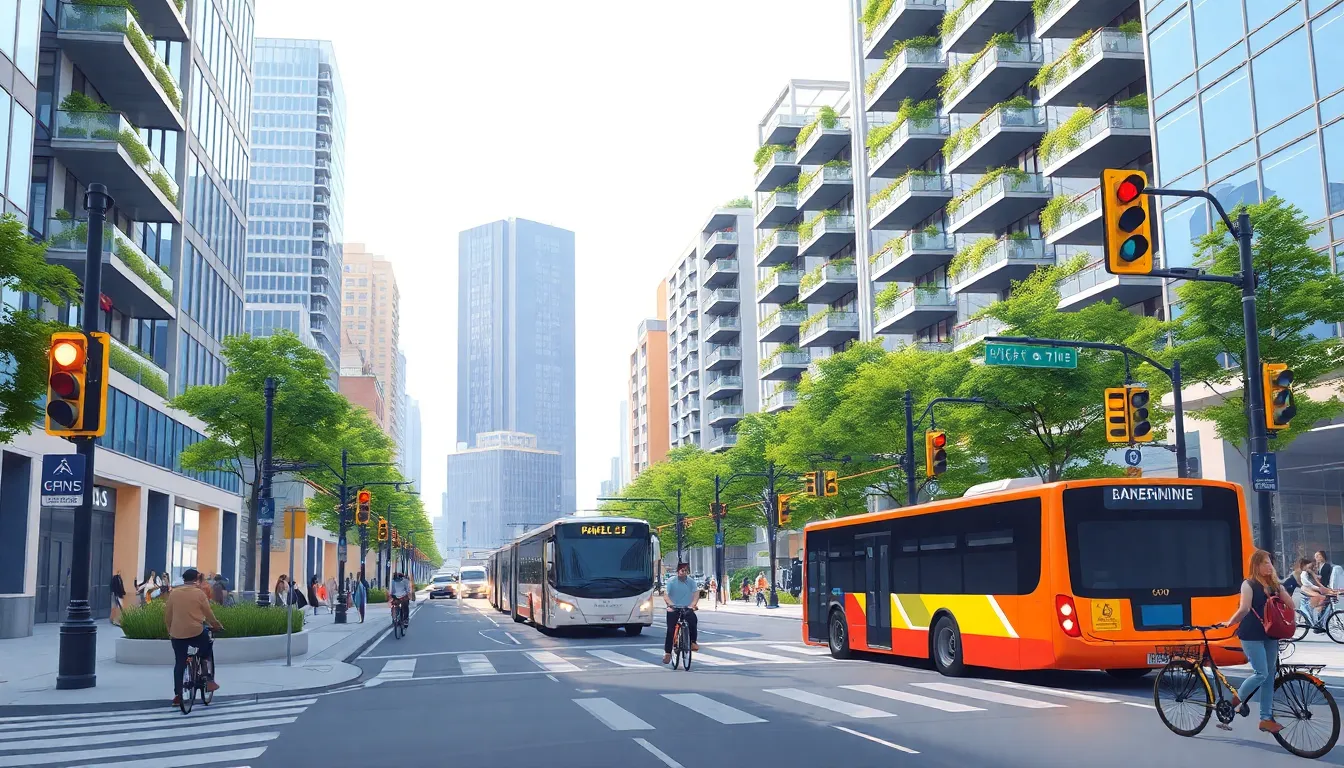Table of Contents
ToggleImagine a city where traffic jams are a thing of the past, public services run like clockwork, and residents feel more connected than ever. Welcome to the world of smart city infrastructure, where technology and urban planning join forces to create a seamless living experience. It’s like giving your city a brain—one that knows when to turn on the streetlights, adjust the traffic signals, and even remind you to take out the trash.
Overview of Smart City Infrastructure
Smart city infrastructure employs advanced technologies to enhance urban environments, promoting sustainability and efficiency. Internet of Things (IoT) devices enable real-time data collection, allowing cities to respond promptly to challenges. Traffic management systems optimize flow, reducing congestion and improving air quality.
Additionally, smart energy grids offer a more efficient energy distribution, adapting to usage patterns and maximizing renewable energy sources. Waste management solutions integrate sensors that signal when bins are full, streamlining collection routes and reducing operational costs.
Investment in high-speed internet connectivity supports digital services, ensuring residents have access to essential online resources. Public safety enhances as cities utilize smart surveillance systems, improving response times and crime prevention tactics. Community engagement platforms foster direct communication between officials and citizens, allowing for real-time feedback on city operations.
Data analytics shapes urban planning, guiding decisions based on trends and resident needs. Mobility services integrate various transportation options, including shared bikes and autonomous vehicles, to create seamless transit experiences. Public lighting systems adjust based on human presence, contributing to energy conservation and safety.
Collaboration with private sectors accelerates the adoption of innovative solutions, ensuring cities remain competitive. Smart city infrastructure not only improves living conditions but also boosts economic development by attracting businesses and talent. Urban areas thrive as technology continues to revolutionize the way cities function and interact with their inhabitants.
Key Components of Smart City Infrastructure

Smart city infrastructure relies on several essential components that enhance urban life. These elements work cohesively to create a more efficient, responsive environment.
IoT and Sensor Technology
IoT devices play a crucial role in smart cities. These devices collect real-time data from the environment, facilitating efficient resource management. Examples include smart meters that monitor energy usage and connected traffic signals that adjust based on congestion levels. Sensors integrated into public spaces provide valuable insights into air quality and noise pollution. Effective use of this technology enables cities to respond quickly to challenges, ensuring a healthier urban atmosphere.
Data Management and Analytics
Data management is vital for informed urban decision-making. Municipalities collect vast amounts of data from various sources, including IoT devices, public transportation systems, and citizen feedback platforms. By employing advanced analytics, cities can identify trends and optimize services. For instance, predictive models can forecast traffic patterns, improving road usage. Additionally, analytics support strategic urban planning, allowing for the growth of green spaces and sustainable infrastructure. Proper data management also enhances transparency, fostering trust between citizens and officials.
Transportation Systems
Smart transportation systems integrate multiple modes of transit to streamline urban mobility. Efficient public transit networks utilize real-time data to improve schedules and reduce wait times. Ride-sharing applications complement traditional transport, offering flexibility to commuters. Infrastructure improvements include dedicated lanes for buses and bicycles, promoting sustainable travel options. The deployment of smart traffic management systems reduces congestion and enhances safety on roadways. These interconnected solutions contribute to a well-functioning urban ecosystem.
Benefits of Smart City Infrastructure
Smart city infrastructure delivers significant advantages, enhancing urban life through innovative technology.
Improved Quality of Life
Smart city initiatives often lead to reduced congestion through optimized traffic management. Enhanced public transport options provide residents access to efficient transit systems. Real-time data on air quality ensures healthier environments for citizens, while connected services simplify daily tasks. Safety measures like smart surveillance enhance neighborhood security, fostering a greater sense of community. Access to digital resources is improved via high-speed internet, facilitating better communication and information sharing among residents.
Enhanced Sustainability
Sustainable energy solutions are a key component of smart cities, promoting efficient resource use and reducing waste. Smart energy grids optimize electricity distribution, minimizing outages and conserving resources. Waste management processes are refined through integrated sensor technology, resulting in timely collections and decreased landfill usage. Urban greenery initiatives improve air quality and mitigate heat effects, creating more livable spaces. Data-driven analytics inform policies aimed at sustainability, ensuring the city’s growth aligns with environmental responsibilities.
Challenges in Implementing Smart City Infrastructure
Implementing smart city infrastructure faces several significant challenges. These obstacles can hinder progress and effectiveness in enhancing urban living.
Technological Barriers
Adopting smart technologies presents various hurdles. Legacy systems often resist integration with new IoT devices, creating compatibility issues. Security concerns about data privacy add another layer of complexity, with cities needing robust protective measures against cyber threats. Additionally, a lack of standardization across devices complicates implementation and interoperability. Training personnel in modern technologies is essential, but the existing skill gaps can delay deployment and reduce efficiency.
Funding and Investment Issues
Funding smart city projects remains a critical challenge. Many cities struggle to secure adequate investment for large-scale initiatives, hindering advancements. Public funding sources often fall short, requiring partnerships with private sectors for financial support. Uncertain returns on investment can deter potential investors from committing to long-term projects. Furthermore, financial planning must prioritize technological upgrades and maintenance to achieve sustainability, ensuring that cities can adapt as needs evolve.
Smart city infrastructure represents a transformative approach to urban living. By harnessing advanced technologies cities can enhance efficiency sustainability and quality of life for residents. The integration of IoT devices and data analytics paves the way for informed decision-making and effective resource management.
While challenges exist in implementation such as funding and data privacy concerns the potential benefits far outweigh the obstacles. Successful collaboration between public and private sectors will be crucial in overcoming these hurdles. As cities continue to evolve embracing smart infrastructure will not only improve daily life but also foster a more connected and sustainable future for urban communities.







